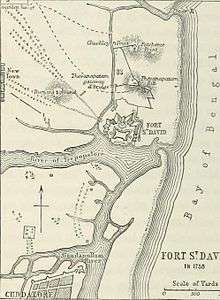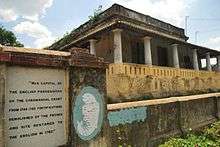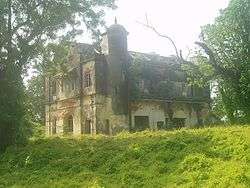Fort St. David
| Fort St David | |
|---|---|
| Part of Tamil Nadu | |
| Cuddalore district, Tamil Nadu, India | |
|
Fort St David | |
 Fort St David | |
| Coordinates | 11°45′N 79°45′E / 11.75°N 79.75°E |
| Type | Fort |
| Site information | |
| Controlled by | Government of Tamil Nadu |
| Condition | Ruins |
Fort St David, now in ruins, was a British fort near the town of Cuddalore, a hundred miles south of Chennai on the Coromandel Coast of India.
History

Fort St David, situated on the mouth of River Gadilam, has a memorable history. The region was under the domains of the Nayaks of Gingee. The Dutch in early 17th century wishing to expand their trade in the Bay of Bengal region and take advantage of the local manufacturing of goods choose the Cuddalore region and sought the permission of Krishnappa Nayaka of Gingee, to build a fort at Devanampatnam which was, subsequently granted in 1608 and construction was started. But the Nayak pulled back after the Portuguese, then dominant players at the Coramandal Coast trade, pressured Gingee's overlord rulers, Venkata I of Vijayanagara Empire to prevent Dutch entry.[1] Therefore, the fort was left with the Gingee Nayaks under appointed traders. Overseas trade continued and the port became an important source of sandalwood, camphor, cloves, nutmeg, mace, green velvet, porcelain, copper, and brass.
Later when Gingee was occupied by the Marathas, Shivaji's son Rajaram Chhatrapati who was under siege in Gingee fort by the Mughal army intended to sell the Devanampatnam fort to the highest European bidder. The British won by out bidding the Dutch and the French. Elihu Yale, Governor of Madras, after long protracted negotiations, acquired the fort and named it Fort Saint David after a Welsh Saint.[2]
The purchase price included not only the fort but also the adjacent towns and villages within the range of a random shot of a piece of ordnance. A great gun was fired to different points of the compass and all the country within its range, including the town of Cuddalore, passed into the possession of the English. The villages thus obtained are still spoken of as cannonball villages.

James Macrae had been governor of the fort and in 1725 he became the Governor of the Madras Presidency.[3] From 1725 onwards the British greatly strengthened the fortifications. In 1746 Fort St David became the British headquarters for the southern India, and attacks by French forces under Dupleix were successfully repulsed.[4] Robert Clive was appointed its governor in 1756; in 1758 the French captured it, but abandoned it two years later to Sir Eyre Coote, KB.

In 1782 the French again retook the fort and restored it sufficiently to withstand a British attack in 1783. In 1785 it finally passed into British possession.
References
- ↑ text of "History_Of_Gingee_And_Its_Rulers"
- ↑ Encyclopædia Britannica entry on Fort St David
- ↑ Cuthbertson, Page 33
- ↑ Naravane, M.S. (2014). Battles of the Honorourable East India Company. A.P.H. Publishing Corporation. pp. 152–154. ISBN 9788131300343.
Sources
- Cuthbertson, David Cuningham (1945). Autumn in Kyle and the Charm of Cunninghame. London : Jenkins.
![]() This article incorporates text from a publication now in the public domain: Chisholm, Hugh, ed. (1911). Encyclopædia Britannica (11th ed.). Cambridge University Press.
This article incorporates text from a publication now in the public domain: Chisholm, Hugh, ed. (1911). Encyclopædia Britannica (11th ed.). Cambridge University Press.
| ||||||
| ||||||||||||||||||||||||||||||||||||||||||||||||||||

